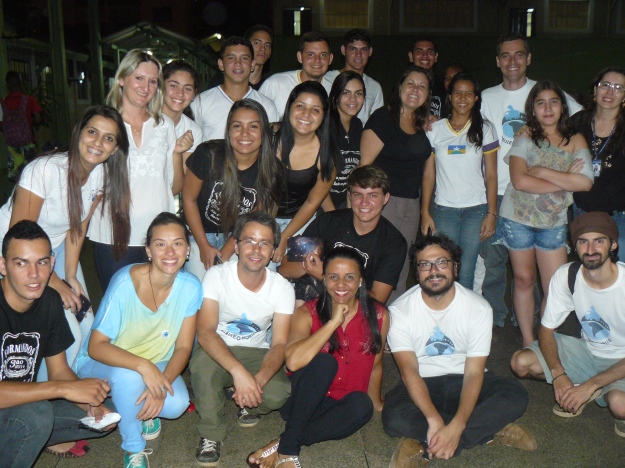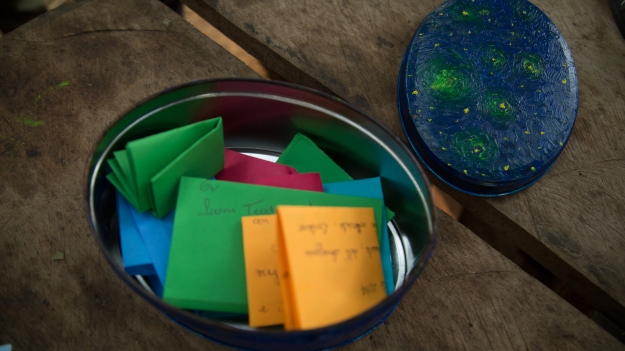by Nuno Gomes
E eis-nos chegados a Cora Coralina, uma escola estadual de ensino fundamental e médio da cidade de Cacoal, na Rondónia.
A Rondónia, estado jovem fundado em 1982, é delimitada a oeste pelo Acre, a norte pelo Amazonas, a este pelo Mato Grosso, e a sul e a oeste pela Bolívia. Tal como os seus vizinhos acrianos (“acreanos”, antes do acordo ortográfico de 1990), os rondonianos são conhecidos por viverem “lá longe”, onde “ninguém vai”. Apesar da aparente inacessibilidade do local, o estado é dos mais diversificados do país em termos de população. É constituído por habitantes oriundos de praticamente todas as regiões brasileiras, possuindo uma forte presença da população amazónica nativa do país.
Outra característica dos rondonianos comum aos seus vizinhos acrianos é o facto de usarem o ar condicionado na máxima potência, com a temperatura no menor valor possível. Como estávamos em pleno “verão amazónico”, o Sol fazia questão de nos saudar diariamente com temperaturas acima dos 30ºC. O tempo abafado, a par das elevadas amplitudes térmicas sentidas entre espaços interiores e exteriores, levou a que, por esta altura, praticamente toda a equipa já tivesse adoecido, ainda que (felizmente) por poucos dias.

Palestra inaugural. Credits: GalileoMobile.
Saímos do hotel bem cedo, pois esta visita iria decorrer durante apenas um dia, em vez dos dois habituais. Chegados à escola, preparámos rapidamente o material necessário para as atividades planeadas, e demos início à sessão inaugural de apresentação da equipa e do projeto. Como não existia auditório que albergasse toda a audiência, a sessão de boas-vindas decorreu no pátio exterior, onde tivemos de improvisar uma tela de projeção com um dos posters que nos acompanhou durante a expedição. Para além da maior parte das turmas que se encontravam na escola no momento, alunos de outras duas instituições de ensino médio também fizeram questão de marcar presença. A plateia era constituída por crianças dos 10 aos 17 anos, por alguns professores e por membros da direção. Tal como fizéramos anteriormente, decidimos partilhar a palestra entre todos os elementos da equipa, com o microfone a passar de mão-em-mão sempre que o slide mudava. Foi uma forma simbólica de passarmos a mensagem do nosso lema, unidos “sob o mesmo céu”. A apresentação foi, assim, pautada pela diversidade de sotaques. Eu, que sou de Portugal, do outro lado do Atlântico, reforcei a sensação que os alunos entendiam melhor o “português” dos meus colegas falantes de espanhol do que o meu. Não raras vezes fui interpelado em espanhol, e respostas típicas à pergunta “sabem de onde venho?” eram “não sei”, “Espanha”, “Argentina”, “algures da Europa”.

Alunos a assistir à palestra inaugural. Credits: GalileoMobile / Patrícia Figueiró Spinelli.
Um grupo de entusiastas de Astronomia e ciência em geral sentou-se à nossa frente a escutar-nos, e colocou-nos diversas questões relacionadas com a origem do Universo, planetas extrassolares e física fundamental. O mais curioso foi descobrir que nenhum deles tinha intenção de seguir uma carreira científica. Aquelas eram apenas perguntas que os inquietavam, resultado da curiosidade natural em perceber o mundo que os rodeia. Para nós foi um prazer sentir essa motivação pela descoberta e, através da partilha de conhecimentos, poder contribuir para a satisfação desse desejo discreto de saber.
À sessão inaugural seguiu-se uma rápida observação do Sol e, para fechar a manhã, demos ações de formação a professores durante aproximadamente duas horas. Estas sessões consistiram na montagem e utilização de um telescópio refrator simples, do tipo usado por Galileu, e na realização de exercícios práticos do nosso Caderno de Atividades que seguem o método da aprendizagem indutiva. Aos professores que realizaram as ações de formação foi atribuído um diploma aprovado pelo Galileo Teacher Training Program.
This slideshow requires JavaScript.
Após o almoço, pusemos em prática as atividades que tínhamos preparado para os alunos. O cardápio contou com: uma projeção do Sol, na qual identificámos 4 manchas solares (cada uma maior do que o nosso planeta); a aprendizagem do manuseamento de um telescópio; a “visualização” da expansão do Universo através do enchimento de balões; a classificação de galáxias; a perceção das fases da Lua; o visionamento de objetos celestes através de filtros coloridos; uma sessão aberta de perguntas e respostas; e, em estreia absoluta nas expedições do GalileoMobile, uma atividade relacionada com cinema, idealizada pelo realizador do documentário da expedição, Felipe Carrelli. Consistiu na ilustração sequencial de diversas fatias de um disco, que posteriormente eram colocados e visualizados num zootropo. A avaliar pela quantidade de alunos que acorreram à sala à procura de uma vaga, a sessão foi um sucesso.
This slideshow requires JavaScript.
Após o jantar, regressámos à escola para a realização de uma observação do céu, que contou com a presença das turmas noturnas, professores, alunos dos cursos diurnos, amigos e familiares. Fizemos observação a olho nu de algumas constelações (Escorpião e Sagitário) e da Via Láctea, e usámos o telescópio que doámos à escola, bem como o do GalileoMobile, para observarmos Marte e Saturno. A nossa visita terminou com mais uma sessão aberta de perguntas e respostas, que reforçou a ideia de que as questões relacionadas com o Universo não escolhem idades e são transversais a todas as culturas e credos.
O dia terminou na companhia de uma das professoras da escola, que nos levou a provar um saboroso açaí gelado com morangos, servido na tigela. Os batidos feitos a partir deste fruto, que por mim era desconhecido até então, tornaram-se agora num hábito adiado, até que a moda chegue a Portugal.
De Cacoal e de Cora Coralina ficam saudades e memórias agradáveis de gente muito simpática, generosa, ávida de saber, e sempre de braços abertos para nos receber, caso uma futura expedição do GalileoMobile nos conduza de novo a terras da Rondônia.

Despedida. Credits: GalileoMobile.







